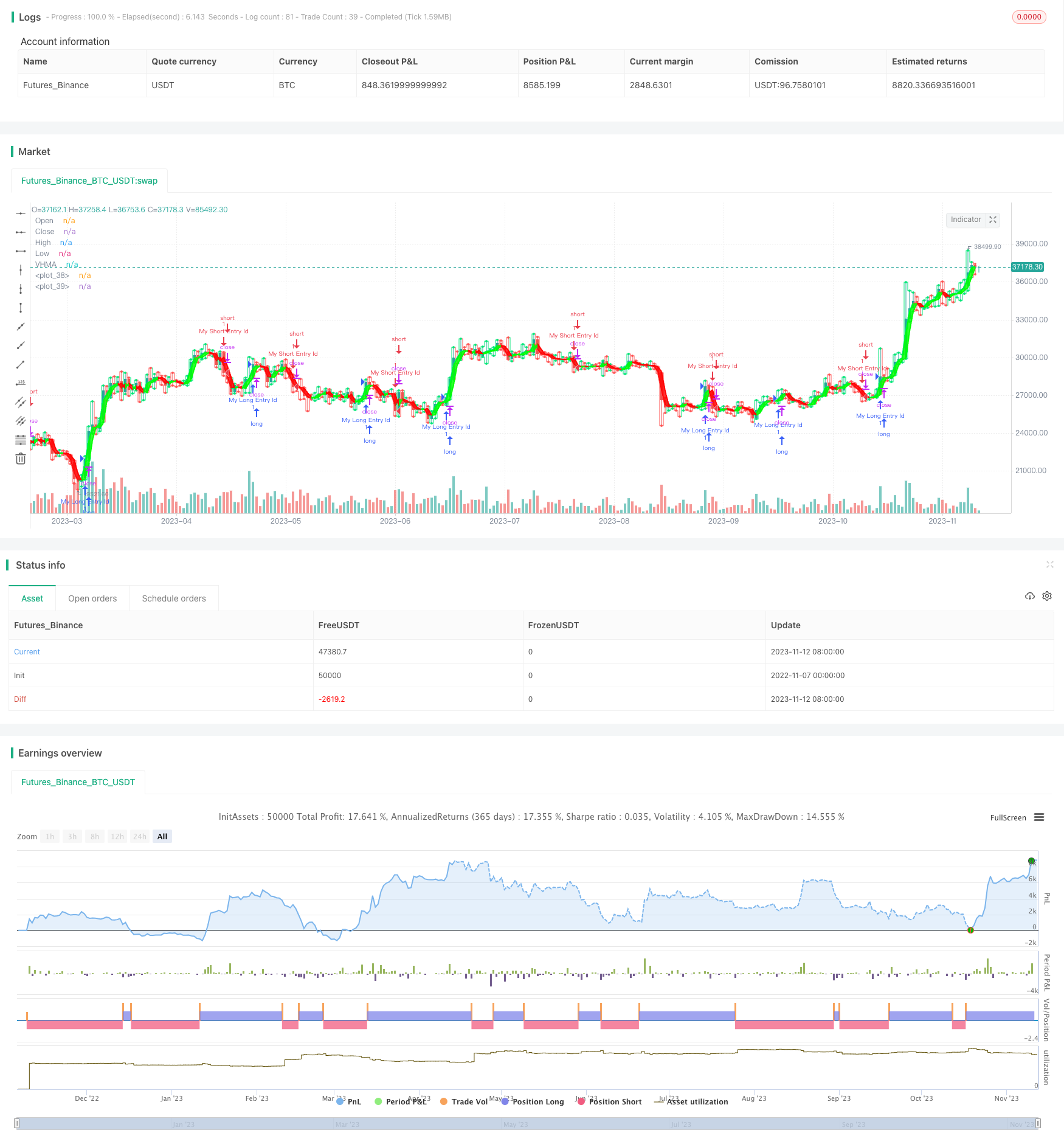
概述
本策略结合均线指标和超趋势指标,实现对趋势的跟随操作。在趋势向上时做多,在趋势向下时做空。
策略原理
计算加权移动平均线MA。使用成交量作为权重,计算一定周期内的加权平均价格。
基于MA计算出Hull移动平均线。Hull移动平均线对价格变化更为敏感。
计算超趋势指标。超趋势指标结合ATR,可以发现价格趋势的变化。计算上轨和下轨。
当收盘价超过上轨时,做多;当收盘价跌破下轨时,做空。
绘制辅助指标,如开盘价、收盘价、最高价、最低价,更直观地观察价格的变动。
根据指标交叉做出买入和卖出决策。
优势分析
该策略同时结合均线指标和超趋势指标,能更准确地捕捉趋势变化。
Hull均线对价格变化更为敏感,有利于及时发现趋势转变。
超趋势指标能动态调整上下轨位,适应市场波动。
辅助指标直观显示价格变动情况,结合指标信号做出判断。
策略参数优化空间大,可调整均线周期、超趋势乘数等参数。
风险分析
在盘整行情中,可能产生虚假信号,导致不必要的交易。
需要同时监控多种指标,策略实现相对复杂。
需要适当调整参数,使指标参数符合不同品种的特点。
需要严格控制止损,避免单笔损失过大。
交易次数可能较多,需要控制手续费的影响。
优化方向
可以测试不同均线的参数,选择对市场更敏感的均线指标。
可以测试不同的超趋势乘数,选择能及时捕捉趋势变化的数值。
可以结合波动率指标,在波动加大时降低仓位。
可以加入突破条件,避免在盘整中出现虚假信号。
可以优化止损策略,使止损更符合市场特点。
总结
本策略同时结合均线指标和超趋势指标判断趋势方向,以跟随趋势进行操作。优点是指标之间可以相互验证,更准确判定趋势。但需要警惕虚假信号的干扰。通过参数优化和风险控制,可以进一步改进策略效果。该策略适合对趋势性较强的品种进行趋势跟随操作。
策略源码
/*backtest
start: 2022-11-07 00:00:00
end: 2023-11-13 00:00:00
period: 1d
basePeriod: 1h
exchanges: [{"eid":"Futures_Binance","currency":"BTC_USDT"}]
*/
// This source code is subject to the terms of the Mozilla Public License 2.0 at https://mozilla.org/MPL/2.0/
// © rajukpatel
//@version=5
strategy('My RK Strategy with Alert', shorttitle='My RK Strategy with Alert', overlay=true )
src5 = input(close)
tf = input(1440)
len5 = timeframe.isintraday and timeframe.multiplier >= 1 ? tf / timeframe.multiplier * 7 : timeframe.isintraday and timeframe.multiplier < 60 ? 60 / timeframe.multiplier * 24 * 7 : 7
ma = ta.ema(src5 * volume, len5) / ta.ema(volume, len5)
//script taken from https://www.tradingview.com/script/kChCRRZI-Hull-Moving-Average/
src1 = ma
p(src1, len5) =>
n = 0.0
s = 0.0
for i = 0 to len5 - 1 by 1
w = (len5 - i) * len5
n += w
s += src5[i] * w
s
s / n
hm = 2.0 * p(src1, math.floor(len5 / 3)) - p(src1, len5)
vhma = p(hm, math.floor(math.sqrt(len5)))
lineColor = vhma > vhma[1] ? color.lime : color.red
plot(vhma, title='VHMA', color=lineColor, linewidth=3)
hColor = true
vis = true
hu = hColor ? vhma > vhma[2] ? #00ff00 : #ff0000 : #ff9800
vl = vhma[0]
ll = vhma[1]
m1 = plot(vl, color=hu, linewidth=1, transp=60)
m2 = plot(vis ? ll : na, color=hu, linewidth=2, transp=80)
fill(m1, m2, color=hu, transp=70)
//
b = timeframe.isintraday and timeframe.multiplier >= 1 ? 60 / timeframe.multiplier * 7 : timeframe.isintraday and timeframe.multiplier < 60 ? 60 / timeframe.multiplier * 24 * 7 : 7
//
res5 = input.timeframe('D')
o = request.security(syminfo.tickerid, res5, open, barmerge.gaps_off, barmerge.lookahead_on)
c = request.security(syminfo.tickerid, res5, close, barmerge.gaps_off, barmerge.lookahead_on)
hz = request.security(syminfo.tickerid, res5, high, barmerge.gaps_off, barmerge.lookahead_on)
l = request.security(syminfo.tickerid, res5, low, barmerge.gaps_off, barmerge.lookahead_on)
col = c >= o ? color.lime : color.red
ppo = plot(b ? o >= c ? hz : l : o, color=col, title='Open', style=plot.style_stepline, transp=100)
ppc = plot(b ? o <= c ? hz : l : c, color=col, title='Close', style=plot.style_stepline, transp=100)
plot(b and hz > c ? hz : na, color=col, title='High', style=plot.style_circles, linewidth=2, transp=60)
plot(b and l < c ? l : na, color=col, title='Low', style=plot.style_circles, linewidth=2, transp=60)
fill(ppo, ppc, col, transp=90)
//
// INPUTS //
st_mult = input.float(1, title='SuperTrend Multiplier', minval=0, maxval=100, step=0.01)
st_period = input.int(50, title='SuperTrend Period', minval=1)
// CALCULATIONS //
up_lev = l - st_mult * ta.atr(st_period)
dn_lev = hz + st_mult * ta.atr(st_period)
up_trend = 0.0
up_trend := c[1] > up_trend[1] ? math.max(up_lev, up_trend[1]) : up_lev
down_trend = 0.0
down_trend := c[1] < down_trend[1] ? math.min(dn_lev, down_trend[1]) : dn_lev
// Calculate trend var
trend = 0
trend := c > down_trend[1] ? 1 : c < up_trend[1] ? -1 : nz(trend[1], 1)
// Calculate SuperTrend Line
st_line = trend == 1 ? up_trend : down_trend
// Plotting
//plot(st_line[1], color = trend == 1 ? color.green : color.red , style = plot.style_cross, linewidth = 2, title = "SuperTrend")
buy = ta.crossover(c, st_line)
sell = ta.crossunder(c, st_line)
signal = input(false)
/////////////// Plotting ///////////////
plotshape(signal and buy, style=shape.triangleup, size=size.normal, location=location.belowbar, color=color.new(color.lime, 0))
plotshape(signal and sell, style=shape.triangledown, size=size.normal, location=location.abovebar, color=color.new(color.red, 0))
if buy
strategy.entry('My Long Entry Id', strategy.long)
if sell
strategy.entry('My Short Entry Id', strategy.short)